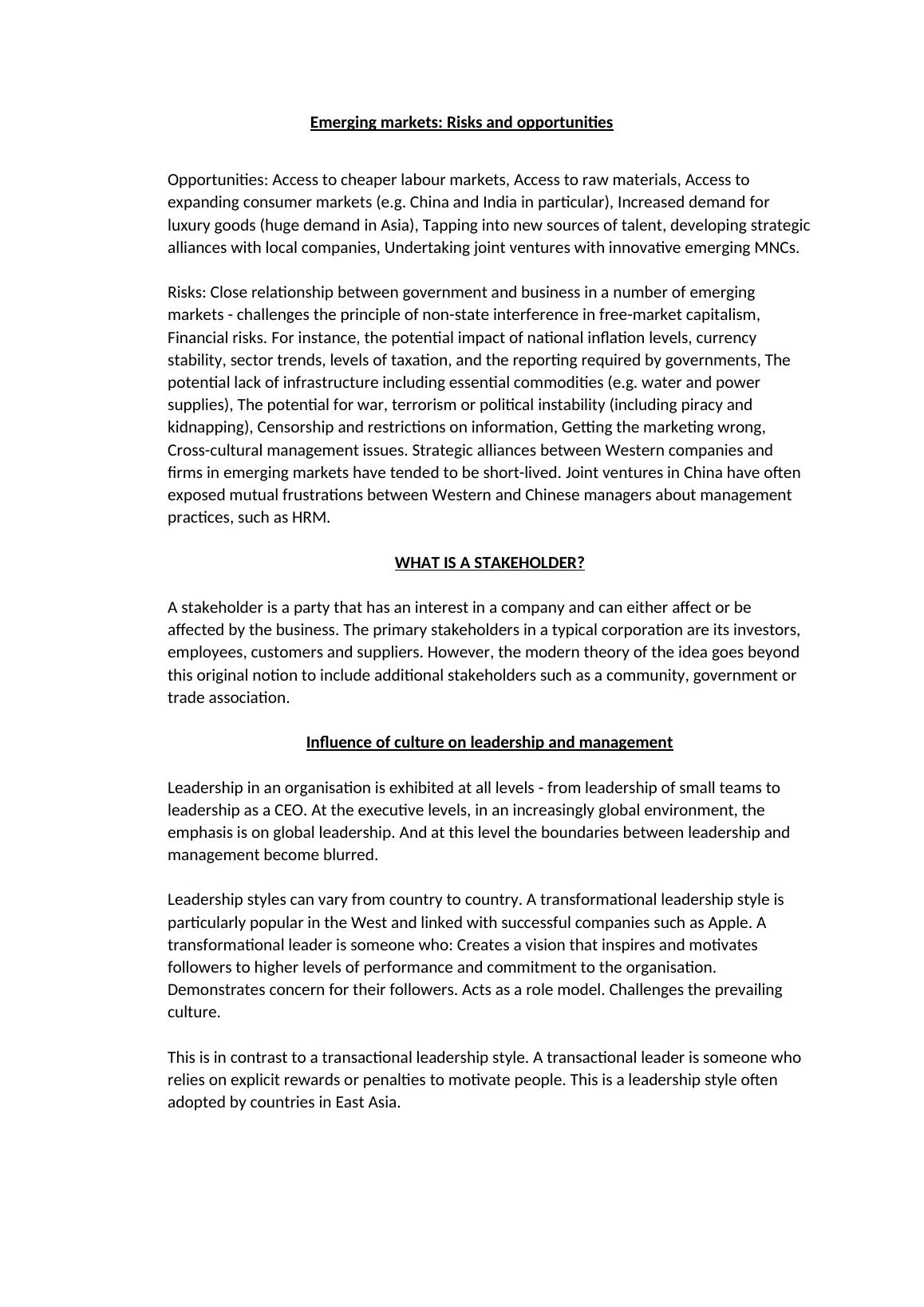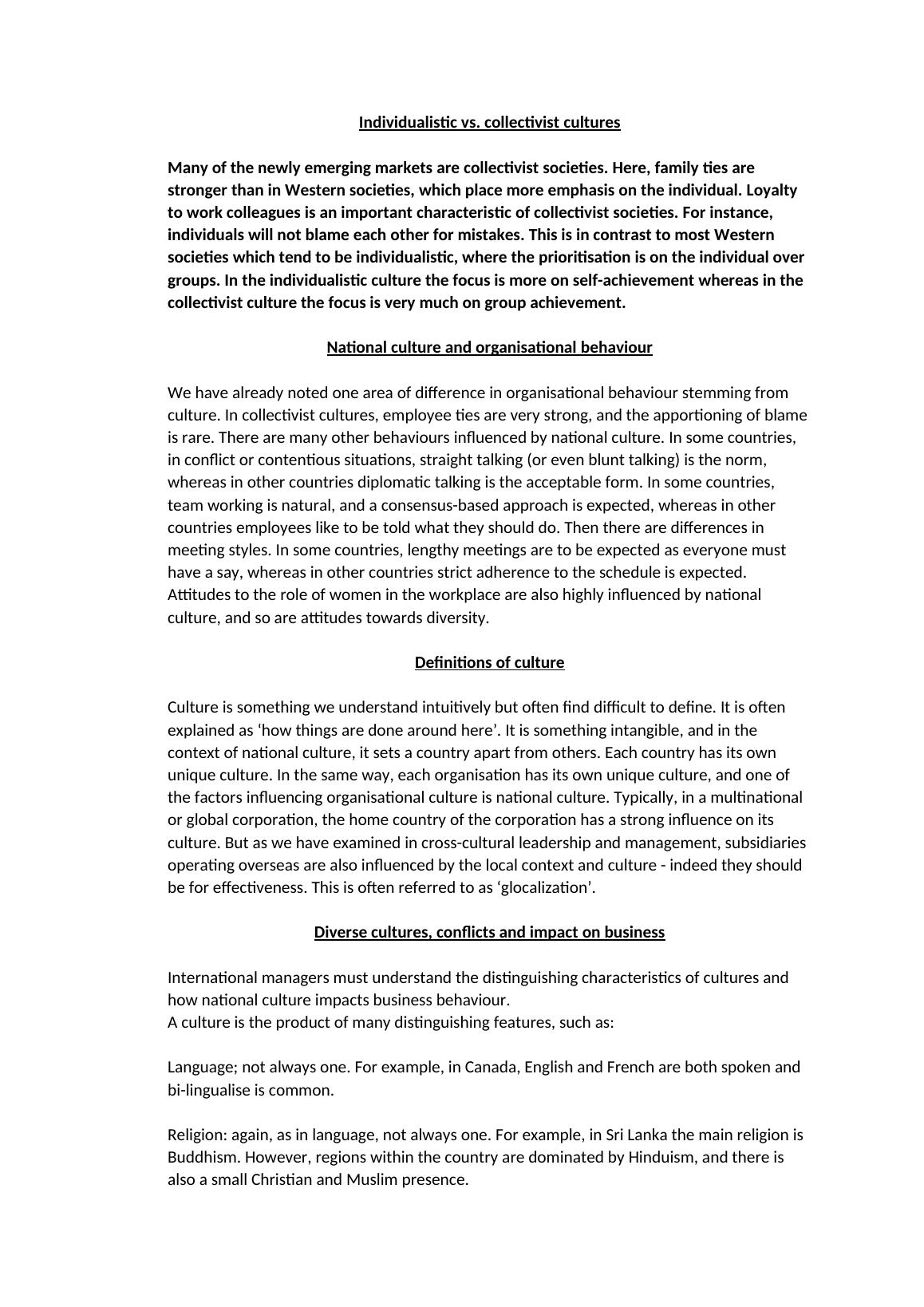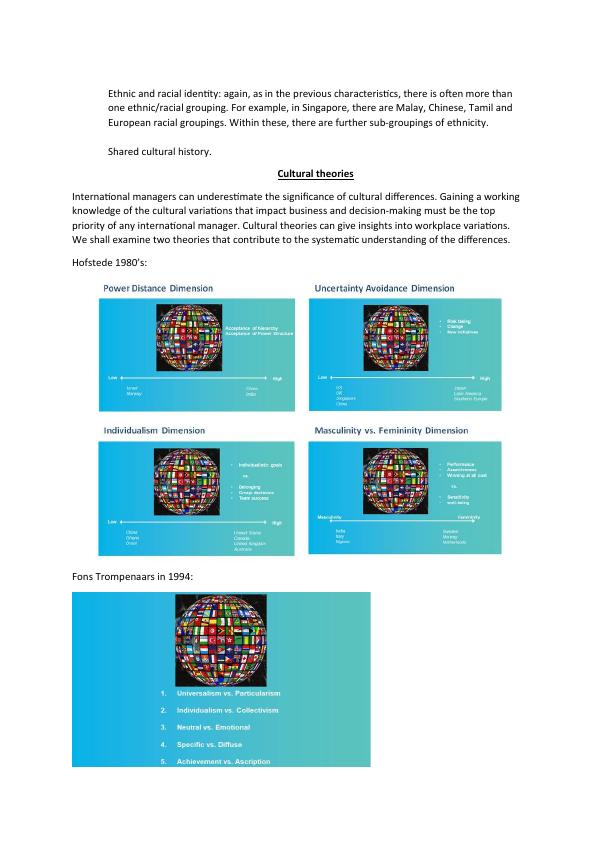ManAGING ACROSS CULTURES LESSON 1 - 10 Changing global context
Added on 2022-05-05
16 Pages6602 Words22 Views
MANAGING ACROSS CULTURES
LESSON 1 – 10
Changing global context
o The business environment in which an organisation operates is characterised by constant
change.
This presents opportunities, threats and challenges. Pre-empting change and then exploiting
suitable opportunities, often global opportunities, is the way firms gain competitive
advantage. However, operating in this changing global context also poses threats and
presents challenges. In particular, it calls for skills in managing people across different
cultures and working with customers, suppliers and strategic partners from diverse cultural
backgrounds.
Deresky (2016) explains how developments and trends within a dramatically changing global
stage present management with a range of challenges including the design and
implementation of global strategies, conducting effective cross-national interactions, and
managing operations in foreign subsidiaries. Deresky (2016) makes the important
observation that “Global companies are faced with varied and dynamic environments in
which they must accurately assess the political, legal, technological, competitive and cultural
factors that shape their strategies and operations. The fate of overseas operations depends
greatly on the international manager’s cultural skills and sensitivity, as well as the ability to
carry out the company’s strategy within the context of the host country’s business
practices.”
WHAT IS GLOBALISATION?
Globalization is the spread of products, technology, information, and jobs across national
borders and cultures. In economic terms, it describes an interdependence of nations
around the globe fostered through free trade.
On the upside, it can raise the standard of living in poor and less developed countries by
providing job opportunity, modernization, and improved access to goods and services. On
the downside, it can destroy job opportunities in more developed and high-wage countries
as the production of goods moves across borders.
Globalization motives are idealistic, as well as opportunistic, but the development of a
global free market has benefited large corporations based in the Western world. Its impact
remains mixed for workers, cultures, and small businesses around the globe, in both
developed and emerging nations.
Find pros and cons
LESSON 1 – 10
Changing global context
o The business environment in which an organisation operates is characterised by constant
change.
This presents opportunities, threats and challenges. Pre-empting change and then exploiting
suitable opportunities, often global opportunities, is the way firms gain competitive
advantage. However, operating in this changing global context also poses threats and
presents challenges. In particular, it calls for skills in managing people across different
cultures and working with customers, suppliers and strategic partners from diverse cultural
backgrounds.
Deresky (2016) explains how developments and trends within a dramatically changing global
stage present management with a range of challenges including the design and
implementation of global strategies, conducting effective cross-national interactions, and
managing operations in foreign subsidiaries. Deresky (2016) makes the important
observation that “Global companies are faced with varied and dynamic environments in
which they must accurately assess the political, legal, technological, competitive and cultural
factors that shape their strategies and operations. The fate of overseas operations depends
greatly on the international manager’s cultural skills and sensitivity, as well as the ability to
carry out the company’s strategy within the context of the host country’s business
practices.”
WHAT IS GLOBALISATION?
Globalization is the spread of products, technology, information, and jobs across national
borders and cultures. In economic terms, it describes an interdependence of nations
around the globe fostered through free trade.
On the upside, it can raise the standard of living in poor and less developed countries by
providing job opportunity, modernization, and improved access to goods and services. On
the downside, it can destroy job opportunities in more developed and high-wage countries
as the production of goods moves across borders.
Globalization motives are idealistic, as well as opportunistic, but the development of a
global free market has benefited large corporations based in the Western world. Its impact
remains mixed for workers, cultures, and small businesses around the globe, in both
developed and emerging nations.
Find pros and cons

Emerging markets: Risks and opportunities
Opportunities: Access to cheaper labour markets, Access to raw materials, Access to
expanding consumer markets (e.g. China and India in particular), Increased demand for
luxury goods (huge demand in Asia), Tapping into new sources of talent, developing strategic
alliances with local companies, Undertaking joint ventures with innovative emerging MNCs.
Risks: Close relationship between government and business in a number of emerging
markets - challenges the principle of non-state interference in free-market capitalism,
Financial risks. For instance, the potential impact of national inflation levels, currency
stability, sector trends, levels of taxation, and the reporting required by governments, The
potential lack of infrastructure including essential commodities (e.g. water and power
supplies), The potential for war, terrorism or political instability (including piracy and
kidnapping), Censorship and restrictions on information, Getting the marketing wrong,
Cross-cultural management issues. Strategic alliances between Western companies and
firms in emerging markets have tended to be short-lived. Joint ventures in China have often
exposed mutual frustrations between Western and Chinese managers about management
practices, such as HRM.
WHAT IS A STAKEHOLDER?
A stakeholder is a party that has an interest in a company and can either affect or be
affected by the business. The primary stakeholders in a typical corporation are its investors,
employees, customers and suppliers. However, the modern theory of the idea goes beyond
this original notion to include additional stakeholders such as a community, government or
trade association.
Influence of culture on leadership and management
Leadership in an organisation is exhibited at all levels - from leadership of small teams to
leadership as a CEO. At the executive levels, in an increasingly global environment, the
emphasis is on global leadership. And at this level the boundaries between leadership and
management become blurred.
Leadership styles can vary from country to country. A transformational leadership style is
particularly popular in the West and linked with successful companies such as Apple. A
transformational leader is someone who: Creates a vision that inspires and motivates
followers to higher levels of performance and commitment to the organisation.
Demonstrates concern for their followers. Acts as a role model. Challenges the prevailing
culture.
This is in contrast to a transactional leadership style. A transactional leader is someone who
relies on explicit rewards or penalties to motivate people. This is a leadership style often
adopted by countries in East Asia.
Opportunities: Access to cheaper labour markets, Access to raw materials, Access to
expanding consumer markets (e.g. China and India in particular), Increased demand for
luxury goods (huge demand in Asia), Tapping into new sources of talent, developing strategic
alliances with local companies, Undertaking joint ventures with innovative emerging MNCs.
Risks: Close relationship between government and business in a number of emerging
markets - challenges the principle of non-state interference in free-market capitalism,
Financial risks. For instance, the potential impact of national inflation levels, currency
stability, sector trends, levels of taxation, and the reporting required by governments, The
potential lack of infrastructure including essential commodities (e.g. water and power
supplies), The potential for war, terrorism or political instability (including piracy and
kidnapping), Censorship and restrictions on information, Getting the marketing wrong,
Cross-cultural management issues. Strategic alliances between Western companies and
firms in emerging markets have tended to be short-lived. Joint ventures in China have often
exposed mutual frustrations between Western and Chinese managers about management
practices, such as HRM.
WHAT IS A STAKEHOLDER?
A stakeholder is a party that has an interest in a company and can either affect or be
affected by the business. The primary stakeholders in a typical corporation are its investors,
employees, customers and suppliers. However, the modern theory of the idea goes beyond
this original notion to include additional stakeholders such as a community, government or
trade association.
Influence of culture on leadership and management
Leadership in an organisation is exhibited at all levels - from leadership of small teams to
leadership as a CEO. At the executive levels, in an increasingly global environment, the
emphasis is on global leadership. And at this level the boundaries between leadership and
management become blurred.
Leadership styles can vary from country to country. A transformational leadership style is
particularly popular in the West and linked with successful companies such as Apple. A
transformational leader is someone who: Creates a vision that inspires and motivates
followers to higher levels of performance and commitment to the organisation.
Demonstrates concern for their followers. Acts as a role model. Challenges the prevailing
culture.
This is in contrast to a transactional leadership style. A transactional leader is someone who
relies on explicit rewards or penalties to motivate people. This is a leadership style often
adopted by countries in East Asia.

Individualistic vs. collectivist cultures
Many of the newly emerging markets are collectivist societies. Here, family ties are
stronger than in Western societies, which place more emphasis on the individual. Loyalty
to work colleagues is an important characteristic of collectivist societies. For instance,
individuals will not blame each other for mistakes. This is in contrast to most Western
societies which tend to be individualistic, where the prioritisation is on the individual over
groups. In the individualistic culture the focus is more on self-achievement whereas in the
collectivist culture the focus is very much on group achievement.
National culture and organisational behaviour
We have already noted one area of difference in organisational behaviour stemming from
culture. In collectivist cultures, employee ties are very strong, and the apportioning of blame
is rare. There are many other behaviours influenced by national culture. In some countries,
in conflict or contentious situations, straight talking (or even blunt talking) is the norm,
whereas in other countries diplomatic talking is the acceptable form. In some countries,
team working is natural, and a consensus-based approach is expected, whereas in other
countries employees like to be told what they should do. Then there are differences in
meeting styles. In some countries, lengthy meetings are to be expected as everyone must
have a say, whereas in other countries strict adherence to the schedule is expected.
Attitudes to the role of women in the workplace are also highly influenced by national
culture, and so are attitudes towards diversity.
Definitions of culture
Culture is something we understand intuitively but often find difficult to define. It is often
explained as ‘how things are done around here’. It is something intangible, and in the
context of national culture, it sets a country apart from others. Each country has its own
unique culture. In the same way, each organisation has its own unique culture, and one of
the factors influencing organisational culture is national culture. Typically, in a multinational
or global corporation, the home country of the corporation has a strong influence on its
culture. But as we have examined in cross-cultural leadership and management, subsidiaries
operating overseas are also influenced by the local context and culture - indeed they should
be for effectiveness. This is often referred to as ‘glocalization’.
Diverse cultures, conflicts and impact on business
International managers must understand the distinguishing characteristics of cultures and
how national culture impacts business behaviour.
A culture is the product of many distinguishing features, such as:
Language; not always one. For example, in Canada, English and French are both spoken and
bi-lingualise is common.
Religion: again, as in language, not always one. For example, in Sri Lanka the main religion is
Buddhism. However, regions within the country are dominated by Hinduism, and there is
also a small Christian and Muslim presence.
Many of the newly emerging markets are collectivist societies. Here, family ties are
stronger than in Western societies, which place more emphasis on the individual. Loyalty
to work colleagues is an important characteristic of collectivist societies. For instance,
individuals will not blame each other for mistakes. This is in contrast to most Western
societies which tend to be individualistic, where the prioritisation is on the individual over
groups. In the individualistic culture the focus is more on self-achievement whereas in the
collectivist culture the focus is very much on group achievement.
National culture and organisational behaviour
We have already noted one area of difference in organisational behaviour stemming from
culture. In collectivist cultures, employee ties are very strong, and the apportioning of blame
is rare. There are many other behaviours influenced by national culture. In some countries,
in conflict or contentious situations, straight talking (or even blunt talking) is the norm,
whereas in other countries diplomatic talking is the acceptable form. In some countries,
team working is natural, and a consensus-based approach is expected, whereas in other
countries employees like to be told what they should do. Then there are differences in
meeting styles. In some countries, lengthy meetings are to be expected as everyone must
have a say, whereas in other countries strict adherence to the schedule is expected.
Attitudes to the role of women in the workplace are also highly influenced by national
culture, and so are attitudes towards diversity.
Definitions of culture
Culture is something we understand intuitively but often find difficult to define. It is often
explained as ‘how things are done around here’. It is something intangible, and in the
context of national culture, it sets a country apart from others. Each country has its own
unique culture. In the same way, each organisation has its own unique culture, and one of
the factors influencing organisational culture is national culture. Typically, in a multinational
or global corporation, the home country of the corporation has a strong influence on its
culture. But as we have examined in cross-cultural leadership and management, subsidiaries
operating overseas are also influenced by the local context and culture - indeed they should
be for effectiveness. This is often referred to as ‘glocalization’.
Diverse cultures, conflicts and impact on business
International managers must understand the distinguishing characteristics of cultures and
how national culture impacts business behaviour.
A culture is the product of many distinguishing features, such as:
Language; not always one. For example, in Canada, English and French are both spoken and
bi-lingualise is common.
Religion: again, as in language, not always one. For example, in Sri Lanka the main religion is
Buddhism. However, regions within the country are dominated by Hinduism, and there is
also a small Christian and Muslim presence.

Ethnic and racial identity: again, as in the previous characteristics, there is often more than
one ethnic/racial grouping. For example, in Singapore, there are Malay, Chinese, Tamil and
European racial groupings. Within these, there are further sub-groupings of ethnicity.
Shared cultural history.
Cultural theories
International managers can underestimate the significance of cultural differences. Gaining a working
knowledge of the cultural variations that impact business and decision-making must be the top
priority of any international manager. Cultural theories can give insights into workplace variations.
We shall examine two theories that contribute to the systematic understanding of the differences.
Hofstede 1980’s:
Fons Trompenaars in 1994:
one ethnic/racial grouping. For example, in Singapore, there are Malay, Chinese, Tamil and
European racial groupings. Within these, there are further sub-groupings of ethnicity.
Shared cultural history.
Cultural theories
International managers can underestimate the significance of cultural differences. Gaining a working
knowledge of the cultural variations that impact business and decision-making must be the top
priority of any international manager. Cultural theories can give insights into workplace variations.
We shall examine two theories that contribute to the systematic understanding of the differences.
Hofstede 1980’s:
Fons Trompenaars in 1994:

End of preview
Want to access all the pages? Upload your documents or become a member.
Related Documents
Advantages and Disadvantages of Entering Developed and Developing Marketslg...
|5
|723
|89
Impact of International Joint Ventures on Organizations in Chinalg...
|13
|3435
|397
Cross Border Alliances and the Success Componentslg...
|12
|3893
|318
An Exploration of Cross Cultural Joint Ventureslg...
|26
|7591
|16
International Business: Use of Strategic Alliance in Foreign Market Expansionlg...
|12
|3704
|102
International Strategic Alliance in Businesslg...
|13
|3853
|123
